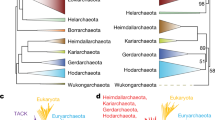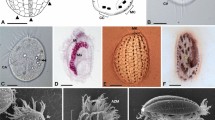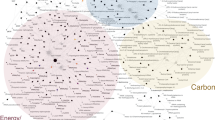Abstract
The origin of eukaryotic cell nuclei by symbiosis of Archaea in Bacteria was proposed on the basis of the phylogenetic topologies of genes1,2,3. However, it was not possible to conclude whether or not the genes involved were authentic representative genes4. Furthermore, using the BLAST5 and FASTA6 programs, the similarity of open reading frame (ORF) groups between three domains (Eukarya, Archaea and Bacteria) was estimated at one threshold7,8. Therefore, their similarities at other thresholds could not be clarified. Here we use our newly developed 'homology-hit analysis' method, which uses multiple thresholds, to determine the origin of the nucleus. We removed mitochondria-related ORFs from yeast ORFs, and determined the number of yeast orthologous ORFs in each functional category to the ORFs in six Archaea and nine Bacteria at several thresholds (E-values) using the BLAST. Our results indicate that yeast ORFs related to the nucleus may share their origins with archaeal ORFs, whereas ORFs that are related to the cytoplasm may share their origins with bacterial ORFs. Our results thus strongly support the idea of nucleus symbiosis.
This is a preview of subscription content, access via your institution
Access options
Subscribe to this journal
Receive 12 print issues and online access
$209.00 per year
only $17.42 per issue
Buy this article
- Purchase on Springer Link
- Instant access to full article PDF
Prices may be subject to local taxes which are calculated during checkout


Similar content being viewed by others
References
Lake, J. A. Nature 331, 184–186 (1988).
Lake, J. A. & Rivera, M. C. Proc. Natl Acad. Sci. USA 91, 2880–2881 (1994).
Moreira, D. & Lopez-Garcia, P. J. Mol. Evol. 47, 517–530 (1998).
Philippe, H. & Forterre, P. J. Mol. Evol. 49, 509–523 (1999).
Altschul, S. F. et al. Nucleic Acids Res. 25, 3389–3402 (1997).
Pearson, W. R. & Lipman, D. J. Proc. Natl Acad. Sci. USA 85, 2444–2448 (1988).
Koonin, E. V., Mushegian, A. R., Galperin, M. Y. & Walker, D. R. Mol. Microbiol. 25, 619–637 (1997).
Andrade, M. A., Ouzounis, C., Sander, C., Tamames, J. & Valencia, A. J. Mol. Evol. 49, 551–557 (1999).
Tatusov, R. L., Koonin, E. V. & Lipman, D. J. Science 278, 631–637 (1997).
Margulis, L. Origin of Eukaryotic Cells (Yale Univ. Press, New Haven, Connecticut, 1970).
Brown, J. R. & Doolittle, W. F. Microbiol. Mol. Biol. Rev. 61, 456–502 (1997).
Rivera, M. C., Jain, R., Moore, J. E. & Lake, J. A. Proc. Natl Acad. Sci. USA 95, 6239–6244 (1998).
Ribeiro, S. & Golding, G. B. Mol. Biol. Evol. 15, 779–788 (1998).
Aravind, L., Tatusov, R. L., Wolf, Y. I., Walker, D. R. & Koonin, E. V. Trends Genet. 11, 442–444 (1998).
Jain, R., Rivera, M. C. Lake, J. A. Proc. Natl Acad. Sci. USA 96, 3801–3806 (1999).
Goffeau, A. et al. Science 274, 563–567 (1996).
Klenk, H. P. et al. Nature 390, 364–370 (1997).
Kawarabayashi, Y. et al. DNA Res. 5, 55–76 (1998).
Bult, C. J. et al. Science 273, 1058–1073 (1996).
Smith, D. R. et al. J. Bacteriol. 179, 7135–7155 (1997).
Kawarabayasi, Y. et al. DNA Res. 6, 83–101 (1999).
Blattner, F. R. et al. Science 277, 1453–1474 (1997).
Fleischmann, R. D. et al. Science 269, 496–512 (1995).
Tomb, F. R. et al. Nature 388, 539–547 (1997).
Deckert, G. et al. Nature 392, 353–358 (1998).
Nelson, K. E. et al. Nature 399, 323–329 (1999).
Kunst, F. et al. Nature 390, 249–256 (1997).
Cole, S. T. et al. Nature 393, 537–544 (1998).
Kaneko, T. et al. DNA Res. 3, 109–136 (1996).
White, O. et al. Science 286, 1571–1577 (1999).
Acknowledgements
We wish to thank Y. Tateno (National Institute of Genetics, Japan) and H. Watanabe (Institute of Medical, Physical and Chemical Research, Univ. Tokyo) for valuable suggestions. We also thank W. Bayar and K. Mizuno for their assistance in the analyses.
Author information
Authors and Affiliations
Corresponding author
Rights and permissions
About this article
Cite this article
Horiike, T., Hamada, K., Kanaya, S. et al. Origin of eukaryotic cell nuclei by symbiosis of Archaea in Bacteria is revealed by homology-hit analysis. Nat Cell Biol 3, 210–214 (2001). https://doi.org/10.1038/35055129
Received:
Revised:
Accepted:
Published:
Issue Date:
DOI: https://doi.org/10.1038/35055129
This article is cited by
-
Evolution of the archaeal and mammalian information processing systems: towards an archaeal model for human disease
Cellular and Molecular Life Sciences (2017)
-
Breaking through a phylogenetic impasse: a pair of associated archaea might have played host in the endosymbiotic origin of eukaryotes
Cell & Bioscience (2012)
-
The evolution of cardiolipin biosynthesis and maturation pathways and its implications for the evolution of eukaryotes
BMC Evolutionary Biology (2012)
-
The early evolution of lipid membranes and the three domains of life
Nature Reviews Microbiology (2012)



